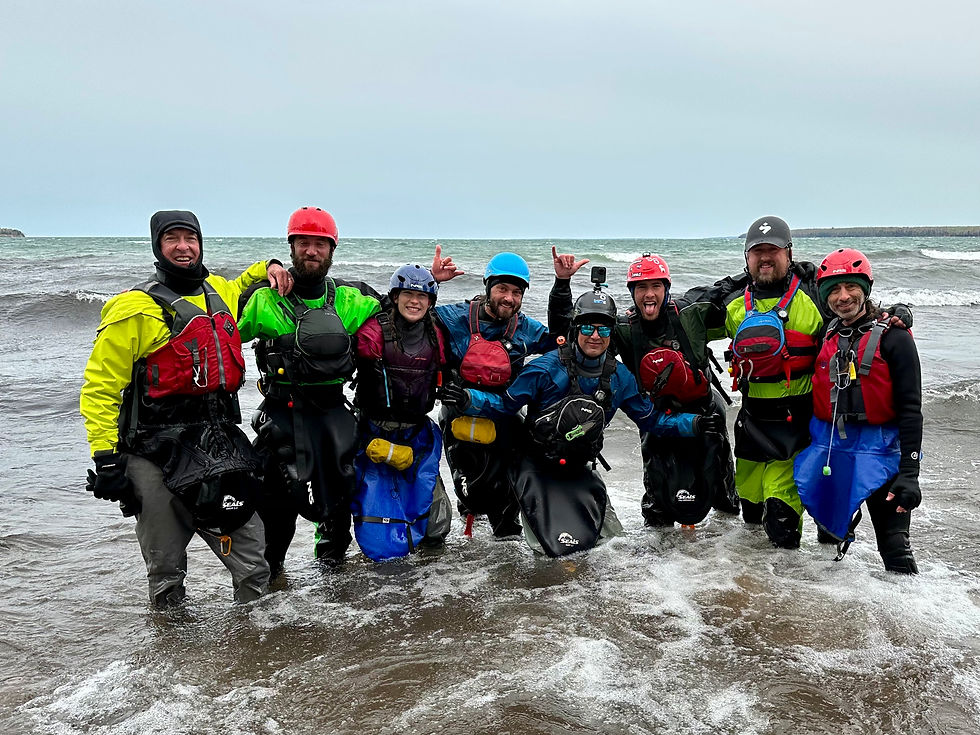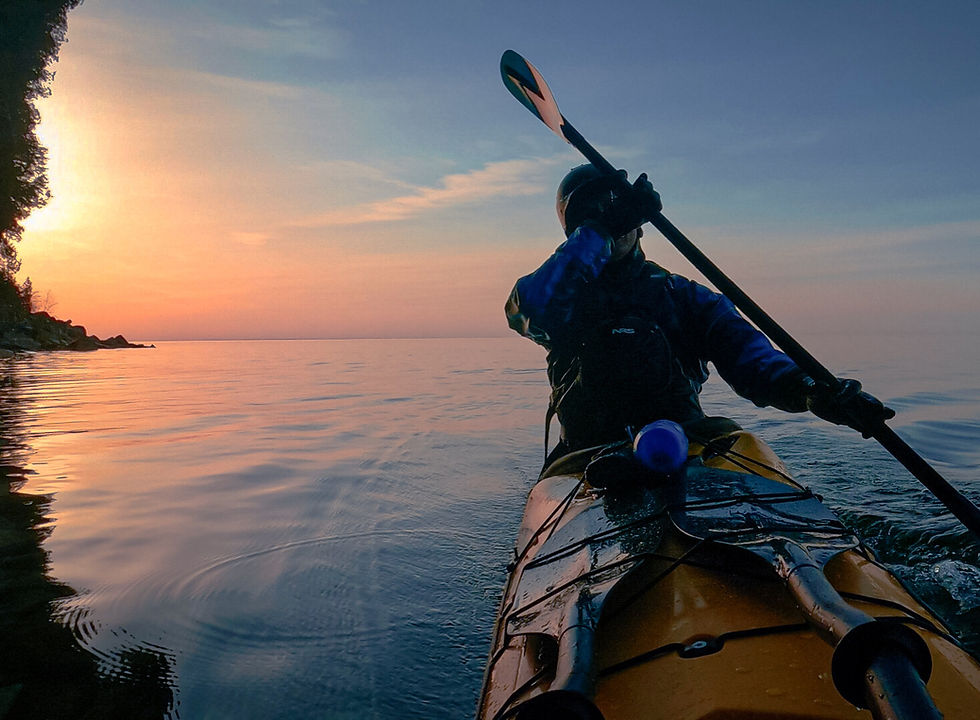Learning to Sea Kayak
- Justin Pahnturat

- Aug 2, 2024
- 5 min read
I wasn't always an experienced, highly trained sea kayaker chasing big waves, paddling in all conditions throughout the year and rolling my kayak every chance I get. I started with humble beginnings of swimming in Lake Michigan, jumping off cliffs at the quarry tubing down the Brule River with my Grandpa or paddling a canoe on a calm, northwoods lake and for many years I was just a recreational paddler that went out on the water once or twice a year in a sit-on-top kayak for short paddles along the shoreline.
What hapened? I ask myself that all the time. How did I make the switch from recreational paddler that was scared of the water to become a proficient sea kayaker? Well, I'm here today to quickly share my story and offer some tips on how to make that transition from sit-on top kayak to a sit-inside sea kayak.

What The Heck Is A Sea Kayak Anyways?
The most common misconception that the public has when it comes to sea kayaking is that they simply don't know what that term even really means. They think, oh, I've been to Walmart and have seen those plastic-bathtub-looking things, I know what kayaking is. Today, I want to stress one thing: all those sit on top plastic kayaks are NOT kayaks, they are hardshell rafts.
A "sea kayak" was invented by early humans over 4,000 years ago in the Arctic region as a way to hunt sea mammals from the water. It wasn't created by Dick's Sporting Goods or Walmart. This ingenious design of this human propelled and highly manuerverable watercraft could withstand waves and wind and keep humans alive on very frigid waters and evolved as a testament to human will power.
Flash forward to modern day, human will power wanes when it comes to hard work and discipline but comfort is really what the masses chase and so sit-on top kayaks were created for people that didn't want to be bothered with learning new skills or technique but rather float on the water for a brief amount of time, snap a photo and then get back to shore. As attention spans shorten, sales of sit on top rafts have skyrocketed- and are now called kayaks.

So I Wanted to Become a Sea Kayaker but Didn't Know How to Get Started
Like most sports these days, needless to say things are very specialized with many genres and styles, so much to the point that it can be ovewhelming trying to figure out where to start. While I am against spending too much time on screens I must say it is amazing how many free resources you can find on the web.
Two people I found were especially helpful and inspring when it came to sea kayaking. Dimitri Vandopoele and Ken Whiting. Both are repsected industry professionals and offer some reallygreat sea kayak instruction for free online. Fun to watch and an amazing resource for the kayak community. Just by watching their instructional videos I was able to get an idea of the fundamentals of paddling.
Seriously, great information from top dogs in the industry. I would record myself as I tried new moves in my sea kayak on the water and would later review the videos to check my form, evaluate progress or mistakes. And then watch more instructional videos.

Those are great ways to get started but the best way to quickly learn and progress is to get instruction from a human with a group of peers or other students. I can honestly say the ACA training and instruction I have received as well as the caliber of amazing kayakers I was lucky enough to study with was the best way to get started on my path to becoming a proficient and skilled kayaker.
Set Your Kayaking Goals
For me, my only real goal was to become good enough to not die in sea kayak. I'd say that's a pretty good reason to study up and practice if I was to continue learning this fascinating watersport. But seriously, becoming an instructor, sponsored sea kayaker, kayak tour business owner was never a thought, I just liked to feeling I got while being out there on the water.

My advice to you is to be honest with yourself, challenge yourself and set some goals because that will decide what kind of kayak you should buy, what kind of gear you should wear and what type of instruction you should seek out.
While self-learning laid the groundwork, the true catalyst for progress was seeking instruction from seasoned professionals. The American Canoe Association (ACA) training programs offered a structured curriculum and hands-on guidance. Collaborating with peers and experienced kayakers not only accelerated my learning but also fostered a sense of camaraderie and shared passion for the sport.
Setting Sail Towards Mastery
At the core of this journey was a simple yet profound goal: to become proficient in sea kayaking. It wasn't about accolades or titles but about honing my skills to navigate the waters safely and confidently. However, the journey didn't stop at mere proficiency. Each milestone actually pushes me forward to learn new things and keep challenging myself. While the ACA keeps track of my progess closely deep down I enjoy tha feeling I get after doing somethong I thogut I'd never be able to do. That's the goal and reward: challenge yourself everyday.
As I mentioned earlier, the best way to get quickly get better is to find a skilled kayaker that is willing to teach you and with the right instructor I promise you will make great strides and hit those rewarding goals you've set for yourself.
Practical Tips for Aspiring Sea Kayakers

For those embarking on their sea kayaking journey, here are some practical tips based on my experience:
Start with the Basics: Master the fundamental paddling techniques that seem boring, practice simple things great posture, getting that forward stroke down before trying to roll right away. Understanding proper technique is vital to safety and enjoyment.
Invest in Quality Equipment: Choose a sea kayak that suits your body type, skill level, and intended use. Quality paddles, safety gear, and apparel are also essential investments that are priceless out on the water. Get good gear, life is short, could be shorter with crappy gear.
Seek Professional Instruction: Enroll in accredited training programs or workshops conducted by experienced instructors like Kayak Guide Justin of Door County, WI.
Practice Regularly: Here's the big secret to progress: get your butt in the kayak seat a nd log many hours. Consistent practice hones your skills and builds muscle memory. Start in calm waters before progressing to more challenging conditions.
Prioritize Safety: Familiarize yourself with safety protocols, including navigation rules, weather forecasting, and rescue techniques. Always wear appropriate safety gear and carry essential supplies.
Join a Community: Engage with local kayaking communities or clubs to connect with like-minded enthusiasts, share experiences, and access resources.
Embrace Continuous Learning: Stay curious and open to new techniques, equipment advancements, and environmental awareness. Attend workshops, read literature, and stay updated on industry trends.
Final Thoughts
Becoming a proficient sea kayaker isn't just about mastering skills; it's a transformative journey that fosters resilience, self-discovery, and a deep connection with nature. Not even kidding, get ready to learn things about yourself and the world. Whether you're drawn to the thrill of paddling through challenging waters or seeking moments of serenity, sea kayaking offers a canvas for personal growth and unforgettable experiences. I speak from experience.
My advice to fellow sea kayaking enthusiasts is simple yet profound: embrace the journey wholeheartedly. Set sail with purpose, immerse yourself in learning, and let the rhythm of the waves guide you towards mastery. See you out on the water!

.png)



Comments